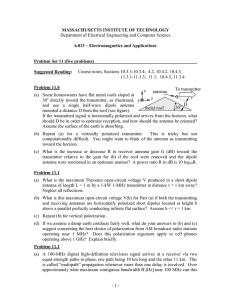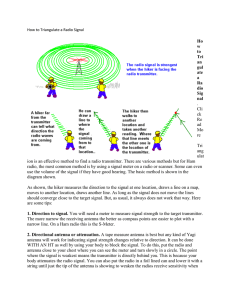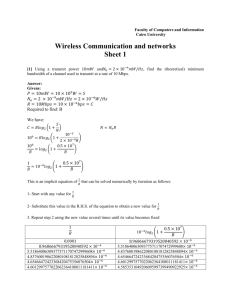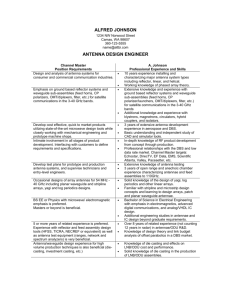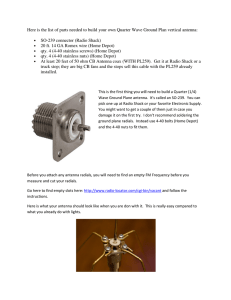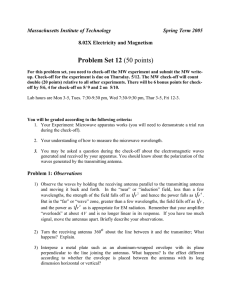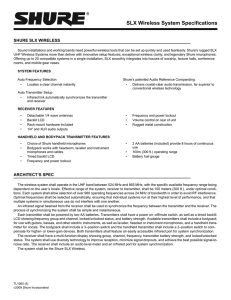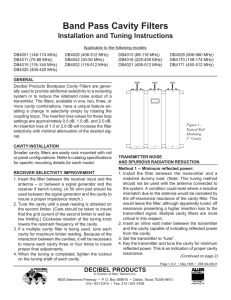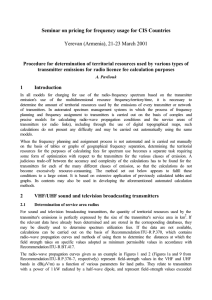MASSACHUSETTS INSTITUTE OF TECHNOLOGY 6.013 – Electromagnetics and Applications
advertisement
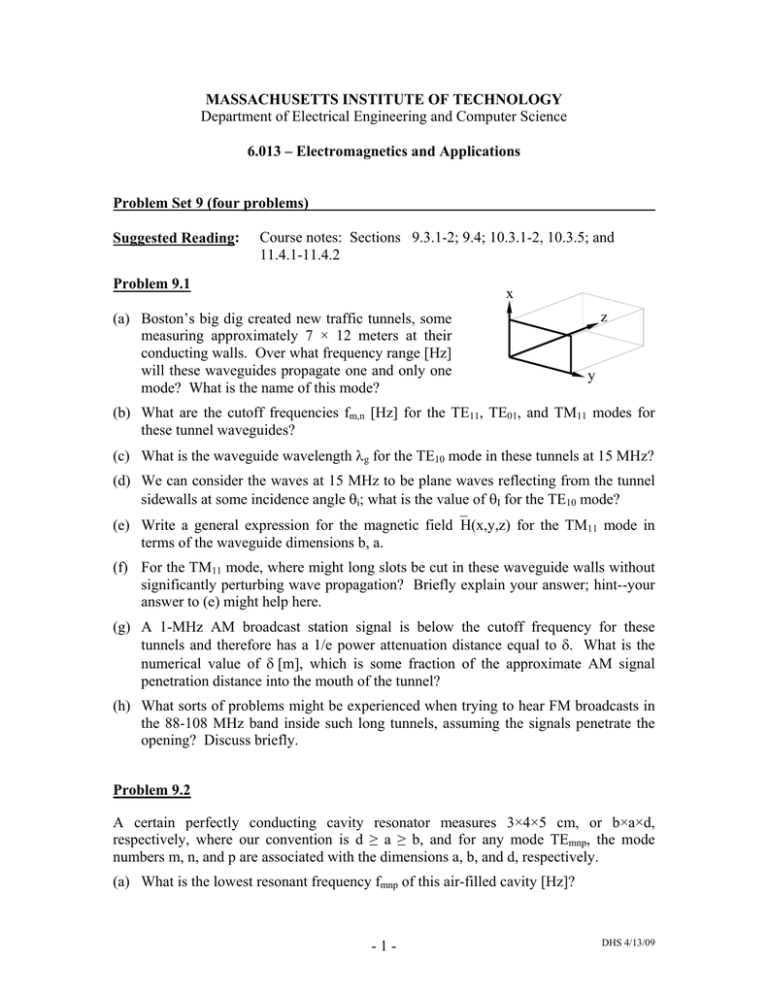
MASSACHUSETTS INSTITUTE OF TECHNOLOGY Department of Electrical Engineering and Computer Science 6.013 – Electromagnetics and Applications Problem Set 9 (four problems) Suggested Reading: Course notes: Sections 9.3.1-2; 9.4; 10.3.1-2, 10.3.5; and 11.4.1-11.4.2 Problem 9.1 x (a) Boston’s big dig created new traffic tunnels, some measuring approximately 7 × 12 meters at their conducting walls. Over what frequency range [Hz] will these waveguides propagate one and only one mode? What is the name of this mode? z y (b) What are the cutoff frequencies fm,n [Hz] for the TE11, TE01, and TM11 modes for these tunnel waveguides? (c) What is the waveguide wavelength λg for the TE10 mode in these tunnels at 15 MHz? (d) We can consider the waves at 15 MHz to be plane waves reflecting from the tunnel sidewalls at some incidence angle θi; what is the value of θI for the TE10 mode? (e) Write a general expression for the magnetic field⎯H(x,y,z) for the TM11 mode in terms of the waveguide dimensions b, a. (f) For the TM11 mode, where might long slots be cut in these waveguide walls without significantly perturbing wave propagation? Briefly explain your answer; hint--your answer to (e) might help here. (g) A 1-MHz AM broadcast station signal is below the cutoff frequency for these tunnels and therefore has a 1/e power attenuation distance equal to δ. What is the numerical value of δ [m], which is some fraction of the approximate AM signal penetration distance into the mouth of the tunnel? (h) What sorts of problems might be experienced when trying to hear FM broadcasts in the 88-108 MHz band inside such long tunnels, assuming the signals penetrate the opening? Discuss briefly. Problem 9.2 A certain perfectly conducting cavity resonator measures 3×4×5 cm, or b×a×d, respectively, where our convention is d ≥ a ≥ b, and for any mode TEmnp, the mode numbers m, n, and p are associated with the dimensions a, b, and d, respectively. (a) What is the lowest resonant frequency fmnp of this air-filled cavity [Hz]? - 1 - DHS 4/13/09 (b) What mode is this? (c) Rank order the resonant frequencies for the modes TE011, TM110, and TE101 from lowest to highest. Explain briefly your method. (d) What is the electric field distribution⎯E(x,y,z) for the TE101 mode? (e) What is the maximum instantaneous total stored electric energy we max for this TE101 mode in terms of the maximum instantaneous electric field Emax? (f) What is the corresponding average power dissipated pd [W] by this TE101 mode if a dielectric the fills the entire cavity and is characterized by εo, μo, and conductivity σ? (g) What is the Q of this lossy TE101 resonance, and what is the associated cavity 1/e energy decay time, τ101 [sec]? (h) How does τ101 compare to the charge and electric field relaxation time τ = ε/σ? (i) Roughly sketch the loci of those points on the cavity walls where to first order a tiny local indentation will not change the resonant frequency f101. Indicate (e.g., cross­ hatch) roughly those portions of the cavity walls where indentation will slightly reduce the resonant frequency. Explain briefly. Problem 9.3 As the owner of a new HDTV broadcasting station at 60 MHz, a decision must be made concerning transmitter power. Assume the data rate transmitted is 18 Mbps (18×106 bits per second), the transmitting antenna has equal gain of ~10dB toward anyone in its customer base, an extra transmitter power margin of 20 dB is desired to compensate for fading due to multipath, and that all customers are located within 60 km, have a TV antenna with 10-dB gain that points toward the transmitter, and also have a TV receiver that needs at least 10-16 Joules per bit of information received. (a) What transmitter power PT [W] is needed? (b) At this transmitter power what is the transmitted wave intensity I [W/m2] for customers 60 km away, assuming there is no fading? (c) What is the effective area Ae [m2] of the customer’s antenna? Problem 9.4 A certain automobile collision-avoidance radar transmits 60-GHz CW pulses forward with an antenna gain G of 10 dB in order to detect pedestrians and automobiles with scattering cross-sections σs greater than 10-2 m2. The receiver requires 10-12 Watts in order to detect such hazards at 50-m range using the same antenna. What is the minimum feasible transmitter power Pt needed for this radar? If the antenna radiation resistance Rr = 100 ohms, what voltage |V| must the transmitter deliver to the matched lossless antenna? - 2 - DHS 4/13/09 MIT OpenCourseWare http://ocw.mit.edu 6.013 Electromagnetics and Applications Spring 2009 For information about citing these materials or our Terms of Use, visit: http://ocw.mit.edu/terms.


